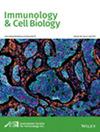微生物反应性人γδ T细胞:金黄色葡萄球菌的特例。
IF 3
4区 医学
Q3 CELL BIOLOGY
引用次数: 0
摘要
v - γ9/ v - δ2 T细胞是人体血液中最大的γδ T细胞群,通过感知亲丁酸蛋白家族成员BTN2A1和BTN3A1中的代谢物(E)-4-羟基-3-甲基-但-2-烯基焦磷酸(HMB-PP),对微生物具有独特的反应性。奇怪的是,金黄色葡萄球菌不产生HMB-PP,但似乎能够诱导v γ - 9/Vδ2 T细胞的活化、细胞因子表达和增殖,其机制在很大程度上是未知的。本文综述了Vγ9/Vδ2 t细胞对金黄色葡萄球菌的反应,并讨论了潜在的途径、配体和生物学功能。本文章由计算机程序翻译,如有差异,请以英文原文为准。
Microbe-responsive human γδ T cells: the peculiar case of Staphylococcus aureus.
Vγ9/Vδ2 T cells represent the largest γδ T-cell population in human blood and possess a unique responsiveness towards microbial organisms by sensing the metabolite (E)-4-hydroxy-3-methyl-but-2-enyl pyrophosphate (HMB-PP) in the context of the butyrophilin family members BTN2A1 and BTN3A1. Curiously, the bacterium Staphylococcus aureus does not produce HMB-PP but appears to be capable of inducing activation, cytokine expression and proliferation of Vγ9/Vδ2 T cells regardless, through a largely unknown mechanism. We here provide a comprehensive review of the existing literature around Vγ9/Vδ2 T-cell responses to S. aureus and discuss potential pathways, ligands and biological functions.
求助全文
通过发布文献求助,成功后即可免费获取论文全文。
去求助
来源期刊

Immunology & Cell Biology
医学-免疫学
CiteScore
7.50
自引率
2.50%
发文量
98
审稿时长
4-8 weeks
期刊介绍:
The Australasian Society for Immunology Incorporated (ASI) was created by the amalgamation in 1991 of the Australian Society for Immunology, formed in 1970, and the New Zealand Society for Immunology, formed in 1975. The aim of the Society is to encourage and support the discipline of immunology in the Australasian region. It is a broadly based Society, embracing clinical and experimental, cellular and molecular immunology in humans and animals. The Society provides a network for the exchange of information and for collaboration within Australia, New Zealand and overseas. ASI members have been prominent in advancing biological and medical research worldwide. We seek to encourage the study of immunology in Australia and New Zealand and are active in introducing young scientists to the discipline.
 求助内容:
求助内容: 应助结果提醒方式:
应助结果提醒方式:


